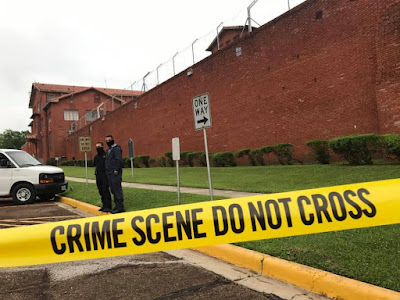Gruesome spectacles of condemned men swelling up, writhing, frothing and turning purple are becoming the norm for executions.
In the death penalty states this year, condemned men strapped to a gurney have writhed, screamed, swelled up, frothed at the mouth, cried as they were burning up and turned purple.
Across America, death row inmates have been pumped with untested concoctions of lethal injection drugs in what amounts to grisly human guinea pig experiments.
In some cases, the drugs have taken longer than expected to work, resulting in excruciatingly drawn out deaths for the inmates and gruesome spectacles for the watchers.
In other cases, the drugs haven’t worked at all.
Welcome to execution 21st century American style, where state prisons are saddled with the reality that the old ways of killing aren’t available any more.
And the new ways are proving not only inefficient, but cruel and inhumane.
Just last week, with a lethal cocktail fizzing through his veins, Rodney Scott Berget asked his executioners at South Dakota State Penitentiary, “is it supposed to feel like this?”
Berget’s execution, for killing prison officer Ronald Johnson with a pipe and encasing his head in plastic wrap, had been delayed hours for a last ditch legal battle over his mental capacity to be put to death by the state.
Three months earlier over in the “cornhusker state”, Carey Dean Moore heaved and gasped and then turned purple until Nebraskan officials drew a curtain around him for 14 minutes.
It was the first time the opioid fentanyl had been used in a lethal injection and it did exterminate the “taxi driver killer” Moore.
But what happened in the mystery quarter hour behind the curtain remains unexplained.
Five days before that, child killer Billy Ray Irick thrashed about and turned a dark purple before finally succumbing.
In the first Tennessee execution since 2009, Irick ate a burger, onion rings, drank a Pepsi, and said sorry for his crimes.
Strapped down in a white prison jumpsuit and black socks, Irick was first injected with Midazolam, a sedative.
Irick had fought execution for three decades since he raped, sodomised and strangled the seven-year-old girl he was babysitting, Paula Dyer.
Officers then injected Irick with vecuronium bromide and potassium chloride, to stop his lungs and heart.
As the drugs took effect, he coughed, choked and gasped for air before his face darkened and he died.
Numbers wise, 2018 has not been a bumper year for executions, just 19 so far with two more scheduled, compared with 35 in 2014.
But the dying has been grim and often macabre, leaving state officials in a quandary of how to more efficiently kill humans.
In the 1990s, lethal injection gained popularity across America, replacing the electric chair and older methods such as the gas chamber and firing squad.
The most common lethal injection drug was the anaesthetic sodium thiopental, used with pancuronium bromide and potassium chloride.
All but one of the 35 US states that carry out executions used sodium thiopental.
But in 2011, the drug’s sole US manufacturer, Hospira, stopped making it.
When it tried to move production to a “state of the art” facility near Milan, the Italian government said it would only license manufacture if the drug was not used in executions.
Several US states’ attempts to obtain the drug from other European manufacturers met with refusals to supply it for death penalty use.
The state of Oklahoma immediately switched to the drug pentobarbital, but a federal judge ruled it fell “short of the level of risk” considered cruel and unusual punishment.
Different states began searching for different drugs, sparking court challenges.
The dilemma facing state executioners is epitomised in the twice postponed execution of Nevada killer, Scott Dozier.
“KILL ME, MAN!”
Sentenced to death for murdering fellow meth dealer, Dozier is urging state officials to execute him.
In 2002, Dozier shot 22-year-old Jeremiah Miller in a Las Vegas strip motel and sawed his body into pieces.
Dozier stuffed them in a suitcase and threw it into a dumpster at the Copper Sands apartments.
Miller’s head, feet and hands were never found.
On death row at Ely state prison, 500km north of Vegas, Dozier has told news reporters, “I lived a life outside the law … kill me, man”.
But eight days before Dozier was scheduled in July to become Nevada’s first inmate executed in a decade, the state switched lethal injection drugs.
The new three drug protocol comprised fentanyl, the sedative midazolam and the paralytic cisatracurium.
A Nevada trial court declared it unconstitutional.
Medical evidence showed cisatracurium could cause Dozier to experience “air hunger” and suffocate to death.
Midazolam has been involved in a number of botched executions, notably that of Dennis McGuire.
In 2014 in Ohio, McGuire received a two drug injection of midazolam and hydromorphone and took 25 minutes to die.
HIS STOMACH SWELLED UP LIKE A HERNIA
In 1989, McGuire had raped and stabbed to death 30 weeks pregnant newlywed Joy Stewart, 22.
Ms Stewart, described as trusting, had got into McGuire’s car while her husband was out working., and was never seen alive again.
Hikers found her body in nearby woods, but McGuire wasn't identified as her killer for three years.
During that time, Ms Stewart’s husband Kenny came under suspicion; he later committed suicide before his name was cleared.
McGuire repeatedly tried to pin the murder on other men, and threw up legal challenges on his road to execution.
Her finally admitted his guilt a month before he was wheeled into Ohio’s death chamber.
A letter written by Ms Stewart’s sister Carol Avery said: “Her murderer destroyed more than one life that day. It is time — past time — for him to pay for what he did to my sister.”
After he was administered the drugs, McGuire’s stomach swelled up, as if he had an instant hernia.
He made alarming snorting noises for several minutes, struggled and gasped audibly for air, as his daughter and Ms Stewart’s family watched on.
His fists clenched, he soundlessly opened and shut his mouth several times, and puffed uselessly like a fish out of water.
Normally, lethal injection results in movement in the early moments of the execution, after which the condemned person lies still.
McGuire lay motionless for five minutes, before the snorting and gulping began.
Other problematic executions include Clayton Lockett in Oklahoma, Joseph Wood in Arizona, and Ronald Smith in Alabama.
Clayton Lockett’s execution, on April 29, 2014 in Oklahoma State Penitentiary, was described as “a horror movie”.
Lockett, 38, was convicted of the 1999 killing of 19-year-old high school graduate Stephanie Neiman.
Lockett had warned Ms Neiman to keep quiet after raping her friend.
He fired at her twice with a shotgun and buried her alive, the dirt puffing up from her shallow grave as he left her to die.
Prison officers had to Taser Lockett to get him to the death chamber.
Once there, doctors pricked him more than 16 times in attempts to get an IV line inserted for the lethal injection.
When a doctor tried to insert a second intravenous line into Clayton Lockett’s groin, he hit the femoral artery and blood began squirting over the execution chamber.
Lockett lived for 43 minutes, convulsing and writhing on the gurney before finally dying of a heart attack.
Also in 2014, Joseph Wood’s death by execution only came after he had been injected 15 times with massive amounts of drugs as he lay gasping and gulping in Arizona’s death chamber.
Two years later, Ronald Bert Smith took 13 minutes to die, heaving and coughing, in punishment for the 1994 slaying of convenience store clerk Casey Wilson.
APRIL 19 - WALTER LEROY MOODY
April in Alabama was the month America’s oldest death row inmate, 83-year-old Walter Leroy Moody, was finally put to death.
Almost 30 years ago, Moody’s simmering hatred for the court system literally exploded with devastating results.
In the 1970s, Walter Leroy Moody had been convicted of possessing a bomb that had hurt his wife when it exploded.
In 1972, he planned a bombing against an car dealer who had repossessed his car.
His failure to have that conviction overturned sparked a rage in Moody, who had attended law school but not finished his studies.
He sent menacing letters to authorities, prepared a “Declaration of War” against an appeals court and began trying to develop “war gases”.
In December 1989, Moody made a bomb out of steel pipe, powder and 80 nails and mailed it to Judge Robert Vance’s home.
When Judge Vance opened the small brown parcel in his kitchen, it exploded killing him instantly and gravely injuring his wife, Helen.
Two days later, another bomb killed African-American lawyer Robert E Robinson, and a third bomb mailed to National Association for the Advancement of Colored People was intercepted.
A Bureau of Alcohol, Tobacco and Firearms chemist noticed a similarity between the bombs and the one Moody had made in 1972.
Moody denied his guilt, but on April 19 death row officials at Holman Correctional Facility near Atmore, Alabama, put him to death.
The execution began at 8.16pm and ended at 8.42pm.
Moody kept his eyes closed and did not respond when given a verbal consciousness check, or respond when asked to give his last words.
His chest moved, his jaw dropping and fingers on his left fingers fluttering.
Moody’s lawyer, Spencer Hahn, took issue with the execution.
“I have attended two executions. In both, my client moved after the consciousness check. Ron Smith’s was more horrific, but both were disturbing, and raise grave concerns,” Hahn said.
“Further, I’d like to know what they gave him before to knock him out and prevent him from getting to give his last words.
“There was no dignity in that room. This dishonoured the memory of Judge Vance and Mr. Robinson.”
MAY 4 - ROBERT EARL BUTTS JR
Robert Earl Butts Jr. was put to death at the Georgia Diagnostic and Classification Prison for the 1996 murder of a 25-year-old corrections officer.
Butts, then aged 18, and Marion Wilson Jr had asked Donovan Corey Parks for a ride from a local Walmart store.
They ordered Mr Parks from the car and shot him in the head.
Asked for a final statement before his execution, Butts declined to offer a prayer and said, “I’ve been drinking caffeine all day”.
Injected with pentobarbital, he said, “It burns, man” as the drugs flowed, then took a series of deep breaths until there was no movement and he was pronounced dead.
FEBRUARY 23 - ERIC SCOTT BRANCH
The last person executed in Florida was Eric Scott Branch, who went down screaming on the death gurney in February.
Lying strapped to the death bed, Branch began arguing with correctional officers, telling them to get the Florida state governor and state attorney general to come and kill him.
“I’ve learned that you’re good people, and this is not what you should be doing,” he said.
The guards turned on the lethal injection process and as the drug began to flow into Branch’s veins, he began to squirm and shout.
Then he screamed: “Murderers! Murderers! Murderers!”
Branch was pronounced dead at 7.05pm.
Branch had been sentenced to die for the brutal rape and killing of 21-year-old Susan Morris, a video production student at the University of West Florida.
Morris had gone missing in January 1993 after leaving a night class.
Branch grabbed her as she walked to her red Toyota on campus because he wanted to steal the car and drive it to his home state of Indiana.
He dragged into a wooded area, raped her, beat her, stomped on her and strangled her to death.
Ms Morris’s naked body was found in a shallow grave.
Police said Branch then took the vehicle and drove it over state lines before being arrested.
His victim’s sister Wendy Morris Hill read out a statement shortly after Branch was put to death.
“Twenty-five years ago, Susan’s life was suddenly and brutally extinguished,” Ms Hill read.
“We have grieved for her longer that she was with us. Yet because of who she was … she will never be forgotten by those who love her.”
FEBRUARY 7, 2019, ALABAMA - DOMINIQUE RAY
On the evening of July 29, 1995, 15-year old Tiffany Harville went missing from her home in Selma, a city in southern central Alabama.
Her mother Mary Coleman filed a missing person’s report, and relatives posted flyers.
Days went by, with no news for Tiffany’s anxious family.
On August 16, a man operating a tractor and bushhog in a cotton field off a county road out of Selma discovered human skeletal remains.
Dental records identified the remains as Ms Harville’s, but forensic examiners found more.
A dozen marks of Ms Harville’s skull were consistent with stab wounds.
Three of the knife wounds were so severe they had penetrated the skull and entered the teenager’s brain area.
Marks on her hand and wrist bones were consistent with defensive wounds.
Police charged a man, Rod Suttle who was known as “Tie” with Tiffany Harville’s murder, but the charges were dropped.
In April, 1997 a 20-year-old male in custody at the local county jail told a police officer he had information about Ms Harville’s death.
Dominique Ray said Tie had cut the girl’s throat and stabbed her in the head in the presence of three other, complicit females.
Four months later, another man Marcus Owden came forward, saying he had been reading the Bible and needed to confess.
It proved that he and Ray had been alone with Ms Harville and the man had raped her while she cried out “God, God, help me. Please help me, God”, and then both had stabbed her.
The men then robbed the girl of $7 and took her underwear.
Owden was sentenced to life in prison, and Dominique Ray received the death penalty.
Months before his trial, Ray had been handed a life sentence for the 1994 slaying of two brothers, 13-year-old Reinhard Mabins and his 18-year-old brother, Ernest Mabins.
Owden also confessed to a role in those killings, saying the Mabins brothers were shot after they refused to join a gang organised by Owden and Ray.
WHO’S NEXT?
In December 2000, seven prison inmates housed in the Texas Corrections’ Connally Unit outside San Antonio pulled off an audacious escape.
Storming the jail armoury and stealing a prison truck, they headed for Dallas where on Christmas Eve, they held up a store and stole $70,000 in cash and 44 guns.
During the robbery, a brave police officer Aubrey Hawkins was shot eleven times and his body was run over.
The so-called Texas 7 were captured a month later, in Colorado, one killing himself before he could be arrested.
The other six were sentenced to death, with three already executed.
A fourth, Joseph Christopher Garcia, is now due to be put to death by lethal injection on December 4, almost 18 years since Officer Hawkins died.
DECEMBER 6, TENNESSEE - DAVID EARL MILLER
David Earl Miller was sentenced to death for the 1981 murder of 23-year-old woman Lee Standifer in Knoxville, Tennessee.
Scheduled for December 6, Miller’s execution has been contested by his lawyers.
The longest serving inmate on Tennessee’s death row, he is just one of several to object that Tennessee’s three-drug lethal injection method “tortures inmates to death”.
Other Tennessee death row inmates have sought the firing squad, while Miller’s attorneys argued death by electrocution would be quicker.
But they maintained that the electric chair and lethal injection are unconstitutional and challenged both methods.
However, Miller has until November 26 to decide how he will die.
Miller was just 22 when he raped mentally disabled Ms Standifer, beat her with a fireplace poker and stabbed her after taking the drug LSD.
TEXAS - KWAME ROCKWELL
On a morning in March 2010, Kwame Rockwell and two others dressed in black and wearing ski masks entered a gas station next to the Fort Worth, Texas used car yard where they worked.
The men knew the station attendant Daniel Rojas and planned to rob the till.
During the robbery, Rockwell shot Rojas in the head and he died at the scene.
Jerry Burnett, a 70-year-old bread delivery man, was also shot and taken to hospital.
He died ten days later.
As the robbery’s organiser, Kwame Rockwell was sentenced to death.
One of his co-accused, Chance Smith, who received a 20-year sentence, testified Rockwell shot the clerk and delivery man inside the store.
Rockwell’s lawyers later argued he had a history of schizophrenia, with hallucinations that snakes and demons invade his body.
In October this year, Texas’ highest court stayed Kwame Rockwell’s scheduled execution.
A trial court will consider whether he is mentally competent to be put to death.
The execution of Kwame Rockwell scheduled for Oct. 24 in Texas has been stayed.
FEBRUARY 13, 2019, OHIO - WARREN HENNESS
Warren Henness is scheduled to be executed in Ohio on February 13 next year.
On March 20, 1992, Henness murdered 51-year-old substance abuse counsellor Richard Myers in Columbus.
Henness knew his victim because Mr Myers was helping him seek drug counselling and treatment for Henness’ wife.
On the day of the murder, Richard Myers picked Henness up in his car and they wwent to a water treatment plant where Henness shot Mr Myers five times in the head.
He then stabbed him in the neck, amputated his ring finger and stole his car and credit cards, which he used to get cash to buy crack cocaine.
Henness has been on death row for 18 years.
Source: news.com.au, Candace Sutton, November 24, 2018
⚑ | Report an error, an omission, a typo; suggest a story or a new angle to an existing story; submit a piece, a comment; recommend a resource; contact the webmaster, contact us:
deathpenaltynews@gmail.com.
Opposed to Capital Punishment? Help us keep this blog up and running! DONATE!
"One is absolutely sickened, not by the crimes that the wicked have committed,
but by the punishments that the good have inflicted." -- Oscar Wilde






.jpg)





